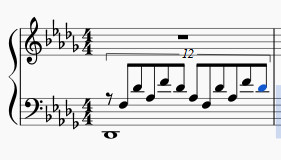I am looking at Franz Liszt's Consolation S.172 No.3. I have checked out two different music scores of the same composition and they both have the same time signature (standard), however the base line includes 12 eighth notes (making it a 3/2 time signature?). My question is how is that possible? How am I supposed to compare the base line with the treble line when they seem to be on different signatures?
I am still relatively new to music theory and appreciate any constructive criticism as to my approach or my vocabulary.
Here is a snippet of what I am talking about. The first two measures of the composition:

Later on you will see this gets even more confusing when the treble is certainly divisible by 8 eighth-notes and the bass is doing its own thing:
Note that this is still standard time. Also note that the second measure here uses eighth notes for both the treble and bass but the treble's eight notes clearly take up more "space" within the measure (four eighth notes are clearly different between the two staffs).



